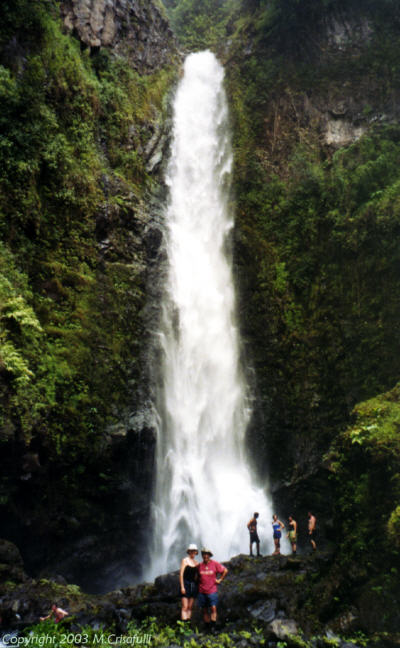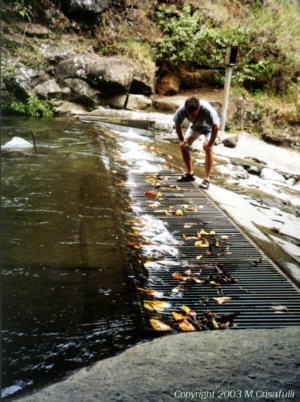

| We | usually do archaeological projects for our annual excursions, but in 2001 we decided to go to Hawaii. Earthwatch was sponsoring a biological survey on Maui and we signed up. |
| The Hawaiian
Islands experience the rain shadow climate effect. The prevailing wind blows the air up
over the central mountains and the moisture laden air cools as it
rises. Clouds form and it begins to rain. The air is usually
dry by the time it descends on the leeward side of the island. The result is a wet side and a dry side. During the colonial period, sugar plantations were set up on the dry side of the islands and elaborate irrigation systems were built to carry water diverted from the streams on the wet side of the islands to the plantations on the dry side. The water from many of these diverted streams never reaches the ocean. This has likely drastically affected several aquatic species that hatch in the head waters of the streams, follow the stream flow to the ocean and then return to headwaters to spawn at the end of their life cycle. These unique species not only manage against strong downstream flows but can actually climb 100-foot waterfalls! Working with Dr. Eric Benbow and field supervisor Mollie McIntosh, our task was to survey and sample several diverted and non-diverted streams to collect data to quantify the effect on stream life and the ecology of the stream system. In the process we visited numerous isolated and exotic locations like Hanawi Falls pictured here. |

|
| We stayed in a condo in Kihei on the dry side and traveled each day in the team van to the various wet-side stream locations to work. We also processed filed data data in a lab set up in condo. Click the image links below for more on each location. | ||||
|
|
|
|
|
|
| Hanawi | Waihee | Iao | Lab work | |

|
The sugar mills are going but the stream diversions will still be needed as tourism expands and new resorts are built on the dry side of the islands. |
|
|
| The photo above of a
diversion grating shows how diversion works in the Hawaiian streams.
Under normal flow nearly all the water runs into the grating as in the
photo. Gary's feet are completely dry. During flooding excess
water flows right over the grate and on to the sea, or to another
diversion lower in the stream. Water resource diversion is not a problem only in the islands, but the limited scale of an island's ecological system makes the effects easier to measure, as well as exacerbating the problem. |
|
You can do this! |
Hawaiian Streams is not currently active, but you can join a similar Earthwatch project in the coming season. Use this link for information. |
This page and its contents
© Copyright 2003 Michael & Karen Crisafulli. All rights reserved.